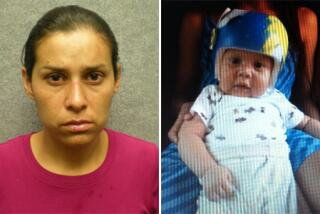Well-behaved, pregnant parolee sent back to prison
Pregnant parolee Amy Ennis knew something was amiss when state parole authorities summoned her to their San Fernando Valley office last New Year’s Eve.
Considered a model parolee 2½ years after being released from prison, she could not fathom why she had to check in with the agency.
She had received positive reviews from those monitoring her progress, she was taking parenting classes to prepare for the birth of her second child, and she was holding down two jobs.
But when Ennis, now 35, showed up at the parole office, she was promptly rearrested and told she had been let out of prison too early: A state bureaucrat had made an error in calculating her sentence.
The mistake left two families — Ennis’ and that of her victim — angry and confused, and it caused the California Department of Corrections and Rehabilitation to change its sentencing review policy.
Ennis now sits in a Chino prison, carrying her second child in a high-risk pregnancy, not knowing when she will be released.
She was handed a six-year prison sentence in 2006 for physically abusing a newborn boy, Joseph Van De Yacht, whom she was baby-sitting in 2004 for a Glendale couple. The baby sustained several serious injuries, including a fractured skull.
Ennis believed that she had served her time.
But when she walked into the parole office on New Year’s Eve 2010, parole officers specializing in capturing fugitives were waiting.
They handcuffed her and told her she was going to the California Institution for Women in Chino.
“They said a mistake had been made and I had to do more time,” Ennis said recently from prison. “I have done everything they told me to do and more.”
Officials with the California Department of Corrections and Rehabilitation concede they made a mistake in calculating the date of her release from prison, which is why they took her back into custody.
“The release and subsequent return of Amy Renee Ennis is due to an unfortunate error by a single employee,” said Luis Patino, a spokesman for the corrections department. “We are confident that the immediate corrective action we are undertaking will create an additional level that helps keep this from happening again.”
In California prisons, nonviolent offenders earn day-for-day credit for good behavior, allowing some to serve only half their sentence.
Ennis, however, was ineligible for that early release. Because her crime — great bodily injury to a child — was classified as violent, she was supposed to serve at least 85% of her six-year sentence, corrections officials said.
Although a prison analyst initially calculated her sentence and release date correctly, a second staffer who reviewed the data recalculated it incorrectly, based on a mistaken assumption that the judge had stricken the sentencing enhancement of great bodily injury, Patino said.
Based on that, the second analyst used a formula allowing Ennis to serve only 50% of her time, Patino said.
Correction officials learned of the error when Oscar Plascencia, a Los Angeles County deputy district attorney who prosecuted Ennis, inquired last year about her release date. They told him she had been freed in September 2008.
“I never heard of such an error in all my years as a prosecutor,” Plascencia said recently.
During Ennis’ 2006 sentencing, Plascencia had argued that her crimes were so heinous, she deserved nine years in prison, not six. He presented evidence of abuse and trauma that left the infant with broken legs and ribs and a skull fracture. Instead, she was credited with time already served.
Bernie Van De Yacht — whose son has since recovered from his injuries, except for some optic nerve damage — said he doubted Ennis had changed.
“What she did to our son shows me that she is lacking anything that resembles a conscience,” he said. “How this could ever happen is beyond comprehension.”
Corrections officials called it a “regrettable but isolated calculation error” and not part of a wider series of mistakes.
Nonetheless, the department introduced a “new statewide policy mandating that if an analyst believes a credit-earning formula is incorrect, as in this case, it cannot be changed unless it is checked and approved by a managerial review at the prison,” Patino said.
The potential for confusion may stem from a recent change in how inmate sentencing information is relayed to prisons.
Counties no longer provide sentencing transcripts to corrections officials, Patino said, so the prison was unaware that Los Angeles County Superior Court Judge Teri Schwartz specifically stated it was a “15% case,” a reference to the maximum amount of credit Ennis could earn for good behavior.
As she sits in the Chino prison, Ennis said, she is finding it hard to get answers about how long she will remain behind bars. Her baby is due May 15.
“No one will speak to me about what is happening,” she said.
Patino told The Times she could be released as soon as early May.
Her attorney, Paul Wallin, called her re-arrest “legally questionable and morally outrageous.”
“I’ve never come across a situation like this,” he said. “It is an inhuman response to a woman with a high-risk pregnancy.”
Ennis’ father, Tom Ennis, said he felt as if his daughter had been snatched away with no explanation.
“It is like they take anyone once they have been inside any time they want,” he said.
More to Read
Start your day right
Sign up for Essential California for news, features and recommendations from the L.A. Times and beyond in your inbox six days a week.
You may occasionally receive promotional content from the Los Angeles Times.







